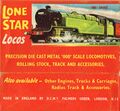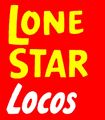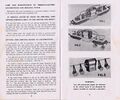Category:Lone Star: Difference between revisions
| Line 22: | Line 22: | ||
|Author="Lone Star"|Publication=Lone Star Locos leaflet}} | |Author="Lone Star"|Publication=Lone Star Locos leaflet}} | ||
=="Treble-O-Lectric"== | ==1960s: "Treble-O-Lectric"== | ||
Technical matters improved in around ~1960 with the company's next generation of "000" trains, which managed the feat of including electric motors in the tiny locomotives. This was quite an achievement considering that none of the larger manufacturers producing 00-gauge had yet attempted to produce a motorised system anywhere near this scale ("[[N gauge]]" appeared somewhat later). | |||
Lone Star managed this by adopting a slightly unconventional approach that borrowed from the method used to provide centralised power to multiple machine tools in Victorian factories - a central powered overhead driveshaft connected to the smaller units by drivebands. In the case of Lone Star locos, this meant a central horizontal electric motor driving a horizontal shaft extending the length of the loco, with multiple rubber bands looped around the shaft, and twisting though 90 degrees to also loop around individual wheel axles. | Lone Star managed this by adopting a slightly unconventional approach that borrowed from the method used to provide centralised power to multiple machine tools in Victorian factories - a central powered overhead driveshaft connected to the smaller units by drivebands. In the case of Lone Star locos, this meant a central horizontal electric motor driving a horizontal shaft extending the length of the loco, with multiple rubber bands looped around the shaft, and twisting though 90 degrees to also loop around individual wheel axles. | ||
Revision as of 17:13, 3 March 2017
| Toy Brands and Manufacturers |
|---|
Lone Star |
Lone Star Locos appeared in the late 1950s as a range of fairly basic 000-scale diecast miniature trains and track (similar-looking to the old Dinky Toys miniature push-along trains, but with clip-together diecast track), and were succeeded in the 1960s by "proper" motorised train sets.
DCMT
The toys were made by the Die Cast Machine Tools Company (DCMT ~1939-1983), which was started just before World War Two. DCMT had made some toy cars for Crescent, and children's enthusiasm for playing "Cowboys and Indians" after the war (fuelled by Hollywood films) created a demand for diecast toy cap-guns, which DCMT supplied under the "Lone Star" brand. When the company then started producing their range of diecast trains, and kept the name, it created a slightly odd situation in which a British company producing models of predominantly British trains had a name that conjured up images of Texas (nicknamed the "Lone Star" state, due to the state flag of Texas having a single star) and the Wild West.
The company went on to make rubber moulded trackside buildings and plastic scenery, and later produced a range of diecast cars, Impy Toys to compete with Corgi and Dinky.
000-gauge – "Treble-0"
Apart from the cap-firing guns, the Lone Star name is often associated with the company's range of small diecast trains.
With no existing "legacy" product line to support, DCMT seems to have decided to try to "leapfrog" the existing model train companies and produce a new, even smaller scale, 000. Where Gauge 0 had been introduced in around 1900 as a smaller alternative to gauge 1, and 00-gauge ("double-O") was half the size of gauge 0 (~16.5mm track spacing rather than just over ~32mm), 000 ("Treble-O") was in turn half the size of 00-gauge, with a spacing between the track rails, after accounting for clearance margins and rounding, of nine millimetres.
" OOO " Scale Details
TREBLE-O-LECTRIC SERIES LOCOMOTIVES and ROLLING STOCK are built to a scale of 2 mm. (5/64") to the foot and TREBLE-O-LECTRIC TRACK is 9mm gauge, that is to say, the measurement between the two inside edges of the rails, in any section of the track, is 9mm. (approximately 23/64).
— , Lone Star, , Treble 0 Lectric Railways Instruction Manual,
1950s: Lone Star Locos Series
The initial trains were simple push-along models with clip-together solid moulded track – although they were rather cute to look at, they had a tendency to "de-rail" when hauled around a track with "jumpy" joints by hand, which meant that for small children, the choice was between having to spend a certain amount of time putting pieces back onto the track, or ignoring the track and using the models as floor toys.
All the locomotives, rolling stock and track items in the Lone Star Locos Series are accurate "000" Gauge and the scope of this exciting railway system increases as each new model is introduced. The Series will eventually include many American and Continental trains. The first of this new group, the famous American Diesel Loco, is now available. Layouts of an extensive and quite complicated nature can be built up and still occupy only a small area, easily accommodated on an ordinary table.
— , "Lone Star", , Lone Star Locos leaflet,
1960s: "Treble-O-Lectric"
Technical matters improved in around ~1960 with the company's next generation of "000" trains, which managed the feat of including electric motors in the tiny locomotives. This was quite an achievement considering that none of the larger manufacturers producing 00-gauge had yet attempted to produce a motorised system anywhere near this scale ("N gauge" appeared somewhat later).
Lone Star managed this by adopting a slightly unconventional approach that borrowed from the method used to provide centralised power to multiple machine tools in Victorian factories - a central powered overhead driveshaft connected to the smaller units by drivebands. In the case of Lone Star locos, this meant a central horizontal electric motor driving a horizontal shaft extending the length of the loco, with multiple rubber bands looped around the shaft, and twisting though 90 degrees to also loop around individual wheel axles.
Lone Star's system avoided the need for high-precision engineered and lubricated gears. Predictably, the system was prone to slippage, which was partly compensated for by the amount for redundancy (each axle being independently driven from the same shaft), but the downside was that the locomotives were fiddly to service when the rubber bands needed adjusting.
The public were dubious about buying a very small cheap system in a non-standard format from a company that they might not have heard of, and the Lone Star 000 electric system is supposed to have disappeared by the mid-1960s (although Beatties still seemed to have some stock in 1967).
External links
Subcategories
This category has the following 5 subcategories, out of 5 total.
I
- Impy Toys (9 F)
L
- Lone Star Flyers (2 F)
- Lone Star Treble-O-Lectric (1 P, 10 F)
T
- Top Boys (empty)
Pages in category ‘Lone Star’
This category contains only the following page.
Media in category ‘Lone Star’
The following 54 files are in this category, out of 54 total.
- A4 Gresley Streamliner, Lone Star Locos (LSLBroc).jpg 2,122 × 897; 602 KB
- Accessory packing section (Lone Star Treble-O-Lectric).jpg 3,000 × 2,295; 1.39 MB
- American Transcontinental Diesel, Lone Star Locos (LSLBroc).jpg 1,419 × 799; 376 KB
- Beatties Pastimes Review No3, Xmas 1967, p3 (MM 1968-01).jpg 888 × 1,200; 470 KB
- Brake Van, Lone Star Locos (LSLBroc).jpg 813 × 617; 183 KB
- Cattle Wagon, Lone Star Locos (LSLBroc).jpg 817 × 563; 175 KB
- Chrysler Imperial, Impy Super Cars (AirfixMag 1966-09).jpg 971 × 1,200; 536 KB
- Class 3 2-6-2 Tank Loco, Lone Star Locos (LSLBroc).jpg 1,269 × 1,009; 379 KB
- Class 3F 0-6-0 Tank Loco, Lone Star Locos (LSLBroc).jpg 1,278 × 792; 231 KB
- Competition winner visits the Palmers Green factory (Lone Star).jpg 2,243 × 3,000; 1.56 MB
- D-Day Invasion Set, Lone Star Products (MM 1964-12).jpg 1,933 × 1,236; 315 KB
- Diecast toy car production line (Lone Star).jpg 2,202 × 3,000; 1.11 MB
- Diesel Locomotive D5900, boxed (Lone Star TrebleOlectric EL-61).jpg 3,200 × 1,231; 1.86 MB
- Diesel Locomotive D5900, side view (Lone Star TrebleOlectric EL-61).jpg 3,200 × 1,012; 1.42 MB
- Diesel Locomotive D5900, underside (Lone Star TrebleOlectric EL-61).jpg 3,200 × 1,702; 1.74 MB
- Diesel Passenger Train Set EL-51, box lid (Lone Star TrebleOlectric).jpg 3,200 × 2,139; 3.71 MB
- Diesel Passenger Train Set EL-51, contents (Lone Star TrebleOlectric).jpg 3,200 × 2,130; 3.06 MB
- Diesel Shunter, 0-6-0, Lone Star Locos (LSLBroc).jpg 1,091 × 825; 285 KB
- Eric Eastwell and AR Mills, Lone Star (circa 1950).jpg 3,000 × 2,212; 1.23 MB
- Flat Truck, Lone Star Locos (LSLBroc).jpg 695 × 376; 93 KB
- Foden Open Truck, box artwork (Impy Toys 24).jpg 2,320 × 1,138; 976 KB
- Foden Open Truck, opened box (Impy Toys 24).jpg 1,800 × 746; 886 KB
- Foden Open Truck, pack description (Impy Toys 24).jpg 1,800 × 651; 891 KB
- Foden Tilt-Cab Truck, Impy Toys (MM 1967-07).jpg 2,422 × 3,000; 2.92 MB
- Goods Wagon (Lone Star Locos).jpg 800 × 456; 150 KB
- Goods Wagons, Lone Star Locos (LSLBroc).jpg 1,096 × 542; 199 KB
- Impy Toys, Logo, colour.png 894 × 433; 191 KB
- Impy Toys, logo.jpg 551 × 243; 40 KB
- Lone Star factories, Palmers Green and Hatfield (BPO 1955-10).jpg 2,672 × 1,302; 686 KB
- Lone Star Flyers, listing (LoneStar 1975).jpg 2,869 × 3,000; 1.74 MB
- Lone Star Locos leaflet, front and back.jpg 1,024 × 753; 389 KB
- Lone Star Locos leaflet, interior.jpg 1,024 × 756; 385 KB
- Lone Star Locos track, underside.jpg 2,200 × 1,467; 2.06 MB
- Lone Star Locos, box, flat.jpg 2,324 × 2,150; 1,011 KB
- Lone Star Locos, logo.jpg 658 × 751; 49 KB
- Lone Star Locos, selection.jpg 1,600 × 1,039; 627 KB
- Lone Star logo.jpg 1,456 × 220; 45 KB
- Lone Star production goes up and up (BPO 1955-10).jpg 1,971 × 3,000; 4.9 MB
- Original pattern and final Lotus toy car (Lone Star).jpg 3,000 × 2,213; 1,009 KB
- Passenger Carriage, EL-071.jpg 3,200 × 1,097; 1.43 MB
- Passenger Carriage, EL-70 (Lone Star TrebleOlectric).jpg 3,200 × 885; 1.24 MB
- Passenger Coach, BR Express, Lone Star Locos (LSLBroc).jpg 1,733 × 674; 361 KB
- Passenger Coach, BR Midland, Lone Star Locos (LSLBroc).jpg 1,188 × 662; 250 KB
- Princess Royal Class Passenger Loco, Lone Star Locos (LSLBroc).jpg 2,108 × 871; 533 KB
- Product range listing, box side (Impy Toys).jpg 1,800 × 853; 1.08 MB
- Publicity photos of a child surrounded by diecast toy cars (Lone Star).jpg 3,000 × 1,846; 1.21 MB
- Station, Lone Star Locos (LSLBroc).jpg 4,031 × 799; 578 KB
- Tank Wagon, Lone Star Locos (LSLBroc).jpg 647 × 515; 127 KB
- Track sections, Lone Star Locos (LSLBroc).jpg 2,298 × 1,324; 692 KB
- Treble-O-Lectric Railways, Instruction Manual, cover (Lone Star).jpg 1,200 × 993; 452 KB
- Treble-O-Lectric Railways, Instruction Manual, loco internals (Lone Star).jpg 2,200 × 1,836; 869 KB
- Treble0Lectric logo.jpg 1,806 × 413; 138 KB
- Volkswagen Micro Bus, Impy Super Cars (AirfixMag 1966-10).jpg 971 × 1,200; 526 KB














































